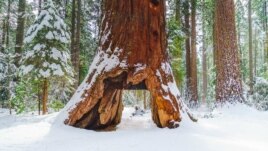10 January, 2017
A powerful storm has brought down one of the most famous trees in the United States.
The huge "Pioneer Cabin Tree" fell Sunday in northern California during a storm that caused severe flooding.
The giant sequoia is famous for having a large hole at the bottom of its trunk. The hole was big enough for people to walk under. In the past, California state officials permitted vehicles to drive through it.
Until now, thousands of people traveled to the Calaveras Big Trees State Park each year to see the giant sequoia.
The park is located east of San Francisco, near Yosemite National Park. Some officials believed the tree was to up to 2,000 years old.
The Calaveras Big Trees Association confirmed reports that the sequoia was no longer standing. "The Pioneer Cabin tree has fallen!" said a message posted to Facebook. The weekend storm was "just too much" for the tree to handle, it added.

The 'Pioneer Cabin Tree' giant sequoia is seen in Calaveras Big Trees State Park in northern California. (Courtesy: California State Parks)
California's Department of Parks and Recreation said in a statement that root and trunk decay had weakened the tree. That area around the sequoia had been closed because of storms and no one was hurt by the falling tree, it added.
Photographs posted on social media showed the fallen tree broken apart in some places as it sat on top of flooded ground. The huge roots that kept the tree in the ground for so many years were showing.
Many visitors to the state park took pictures while standing underneath the famous sequoia. After hearing about the tree, some posted photos and messages on social media about their memories and experiences.
"It's kind of like someone in the family has died," tree admirer Joyce Brown told the Associated Press. Brown, now 65, said she was just 12 when her parents first took her to see the "drive-thru tree." She's now a retired school teacher who spends about one-third of the year at a small cabin near the tree.
The tunnel that made the sequoia famous also weakened it over time. The hole was made in the 1880s to let people and vehicles pass through the tree. This began with horses and buggies and later with cars. Eventually, the path going under the tree was only open to people walking.
Sequoias are the largest tree species in the world. They can reach up to eight meters in diameter.
A volunteer at the Calaveras Big Trees State Park explained that when the already mostly dead tree hit the ground, it broke apart and was completely unrecognizable.
He said the tree quickly went from something "majestic" to pieces of "rubble."
I'm Dorothy Gundy.
Bryan Lynn wrote this story for VOA Learning English, based on reports from VOA News and the Associated Press. George Grow was the editor.
We want to hear from you. Write to us in the Comments section, and visit 51VOA.COM.
________________________________________________________________
Words in This Story
trunk – n. thick stem of a tree that branches grow from
decay – n. process of being slowly destroyed by natural processes
admirer – n. someone respecting or showing approval for a person or thing
tunnel – n. long passage that goes under the ground or an object
diameter – n. the distance through the center of something from one side to the other
majestic – adj. large and impressively beautiful
rubble – n. broken pieces left over from a destroyed building